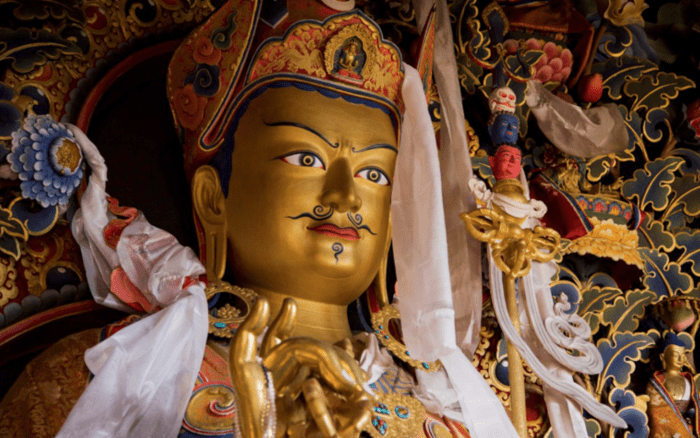
Who is Padmasambhava?
The energy of Padmasambhava is very strong in Bhutan. His special vibration is one of the main reasons I’m here, since he’s been present in my meditations for a long time. Padmasambhava is said to have been born about 700 years after Christ in the NW Indian province of Oḍḍiyāna. He traveled and studied with many great Indian masters, and was able to purify negative obstacles in Tibet and Bhutan to make way for the great tantric schools of Tibetan Buddhism. This was part of a shift away from Bön Buddhism that lasted many centuries.
Statues of Padmasambhava can be found in many sacred monasteries in Bhutan. He is usually depicted with burning intense eyes, a diamond-vajra scepter of compassionate love in his right hand and a skull-bowl of clear wisdom in his left. Padmasambhava traveled far and meditated in countless caves throughout Tibet and Bhutan. One of those is the Tatsang monastery near Paro, called Tiger’s Nest. According to legend, Guru Rinpoche flew to the site as the fiery Dorje Drolo, one of his eight manifestations, on the back of a tigress, a form assumed by his consort Yeshe Tsogyal to subdue the local demon. He and his consort meditated in the cave for three months, and years later in 1692 the Tatsang monastery was built in this place.
Two fires in 1951 and 1998 utterly destroyed the monastery. It was rebuilt in 2000. Countless religious sites carrying the powerful wizardry of Padmasambhava are scattered across Bhutan. I’ve been visiting them to feel his essence, which is very much alive here.
Yeshe Tsogyal, spiritual teacher and consort of PadmaSambhava

Yeshe Tsogyal (757–817 CE) was a consort of Padmasambhava and Mother of Tibetan Buddhism. Born a princess in the region of Kharchen, Tibet, in about 777 CE, she lived for approximately 99 years as a preeminent figure in Tibetan Buddhism and role model for contemporary spiritual practitioners.
Although referred to as Padamasambhava’s main consort, she was primarily a spiritual master and teacher in her own right. She is known to have revealed hidden teachings with Padmasambhava and was also the main scribe for these terma. Later, Yeshe Tsogyal also concealed many of Padmasambhava’s hidden teachings on her own, under the instructions of Padmasambhava for future generations. Based on her spiritual accomplishments, the Nyingma and Karma Kagyu schools of Tibetan Buddhism recognize Yeshe Tsogyal as a female Buddha.
Machig Labdrön, incarnation of Yeshe Tsogyal and compiler of Chöd tradition.
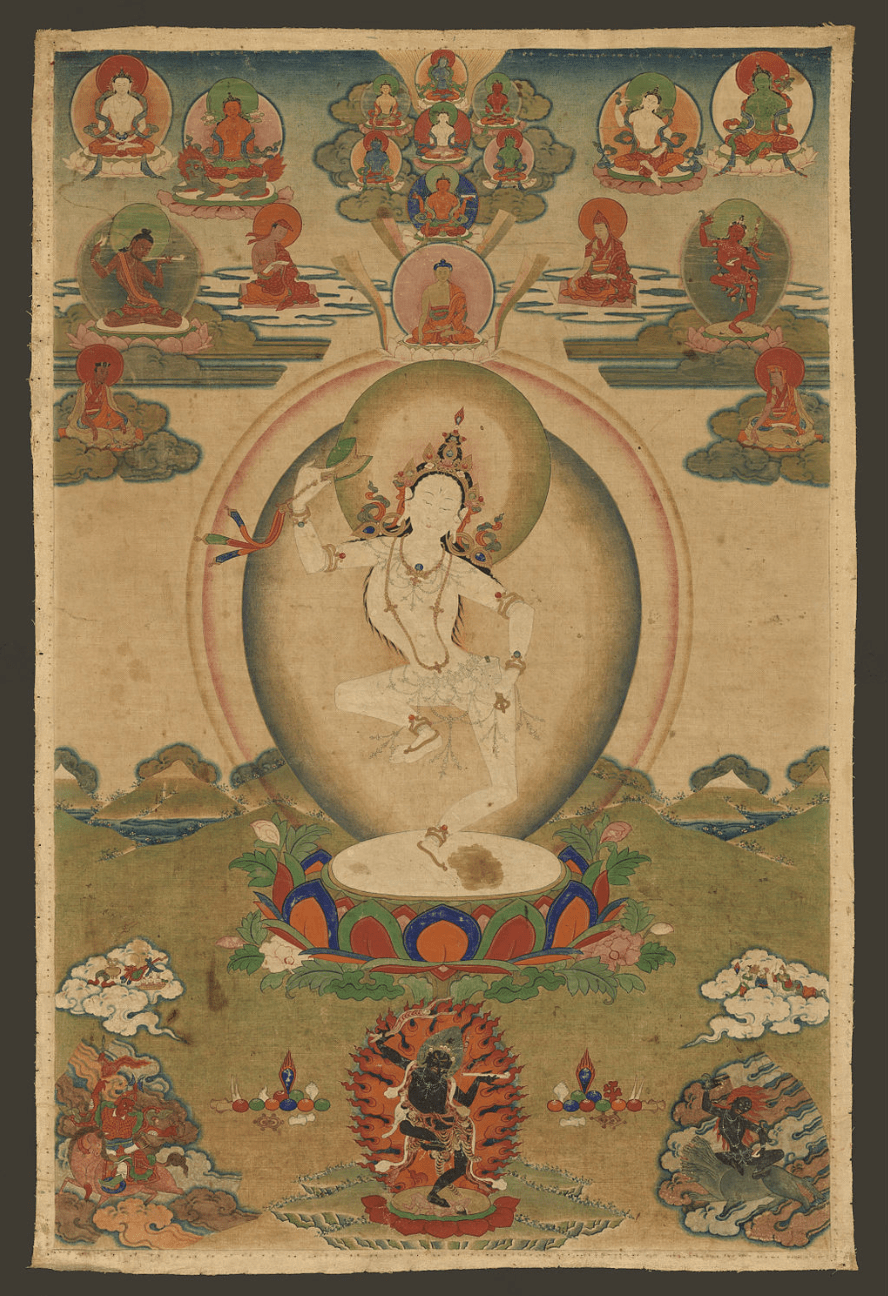
Machig Labdrön (1055 – 1149 CE)
Iconographically, Machig Labdrön is often depicted as a dakini, a representation of enlightened female energy. She holds a damaru drum in her right hand and a ghanta bell in her left. Her right leg is dancing and the standing left leg is bent. Machig is white in color with three eyes and wears the Six Bone Ornaments of the traditional graveyard, which is normal for a practicing yogini.
Machig Labdrön was an incarnation of Yeshe Tsogyal and compiler of Chöd tradition.
Padmasambhava predicted that Yeshe Tsogyal would be reborn as Machig Labdrön, and her consort, Atsara Sale, would become Topabhadra, Machig’s husband. Her assistant and Padmasambhava’s secondary consort, Tashi Khyidren, would be reborn as Machig’s only daughter, and so on. All of the important figures in Yeshe Tsogyal’s life were to be reborn into the life of Machig Lapdron, including Padmasambhava himself, who was said to become Phadampa Sangye.
Tibetan Buddhists believe Machig was the Mind Stream emanation (tulku) of Yeshe Tsogyal, as well as “an emanation of the ‘Great Mother of Wisdom,’ Yum Chenmo,(prajnaparamita) and of Arya Tara, who transmitted to her teachings and initiations.” Buddhists believe this pattern of reincarnations and emanations continued into the life just before her birth.
Even though Machig spent some time living with monastics, she was not a celibate nun. She partnered and had both daughters and sons who became lineage holders. One of her sons even started out as a thief. Machig was eventually able to bring him to the Dharma and became his teacher. She said: “You may think that Gods are the one’s who give you benefits, and Demons cause damage; but it may be the other way round. Those who cause pain teach you to be patient, and those who give you presents may keep you from practising the Dharma. So it depends on their effect on you if they are Gods or Demons.”
Great controversy over Machig Labdrön’s teachings led to a delegation of Brahmins being sent from India to Tibet to assess Machig’s qualifications and teachings. Her students gathered with her at Zangri Khangmar (Machig’s home in Tibet from 39 years of age until her death 99). Machig taught and debated with the Indian pandits. She even sent a delegation to South India to find the relics of Mönlam Drub, thus adding further validity to her status as a teacher and lineage holder. After these and other events, it was determined that Machig’s teachings were indeed authentic and established that the Chöd teachings were the first Buddhist teachings to emerge in Tibet. Thereafter the Chöd practice spread to India.
Machig Labdrön said: “To consider adversity as a friend is the instruction of Chöd”.

Modern Chöd practitioners chant sacred verses with a damaru drum and human thigh bone. Chod combines Prajñāpāramitā philosophy with meditation and tantric ritual. The Chöd practitioner seeks to tap into the power of fear to test their understanding of the impermanence of everything. The Chöd invokes a form of self-sacrifice in which the practitioner visualizes their own body as the offering at a tantric feast for etheric hungry ghosts. The practitioner’s work is to bring about refinement of the pure spirit, to satisfy the etheric spirits and to sever their own attachment to the physical.
Prajñāpāramitā means “the Perfection of (Transcendent) Wisdom” in Mahāyāna Buddhism. Prajñāpāramitā refers to a highly refined way of seeing the nature of reality. It also refers to a particular body of sutras or verses. To achieve total immersion one’s awareness into the deep silence and profound emptiness that is pure potential and the Source of all, the Oneness, is the ultimate goal. It brings wisdom of understanding of the Truth that all other things are inherently impermanent and fleeting.
What is Machig Labdrön’s Chöd Practice?
Machig Labdrön’s Chöd, also known as Mahamudra Chöd, has been widespread in Tibet since her lifetime. It is also called “The Beggars’ Offering” or “The Cutting-Off-Ritual.” Chöd is a visionary Buddhist ceremonial practice of cutting attachment to one’s corporeal form. This means that a practitioner offers the mandala of their own body in a “ganachakra rite”, meaning food and other compassionate offerings are made to alleviate the insatiable hunger of the hungry ghosts in the etheric world. The practitioner works entirely with their own mind, visualizing the offering, and practicing in lonely and dreaded places, such as cemeteries, to overcome all fear. This is also why Chöd is often used to overcome illness, and to assist departed souls to pass into more to peaceful realms. In some lineages of the Chöd, practitioners of use a ritual bell, a specialized Chöd damaru drum, and a human thigh-bone trumpet.
Machig Labdrön’s Chöd, was not new. It was rather a compilation and perfection of previous traditions, drawing together many threads using her great knowledge and refined wisdom into the powerful Chöd she taught.
How Old is the Chöd Practice?
The Chöd practice has prehistoric roots in early Buddhism. Over 18,000 years ago in Tibet, the earliest known Buddha was Tompa Shenrab Miwoche, called the father of Bön Buddhism. He synthesized and vitalized the Tibetan traditions, bringing it together as one system called Bön. In Tibetan language, Bön can mean teach, recite, say, or religion. The Chöd practice was used in all of Bön Buddhism under various other names.
Like Gautama Buddha, Tönpa Shenrab was of royal birth. He renounced his royal inheritance at the age of thirty-one to travel the path to enlightenment. Tonpa Shenrab embraced the life of a renunciate and commenced austerities, spreading the practice of Bon. He taught in the land of Zhangzhung near Mount Kailash.
Sites of Padmasambhava in Nepal and Bhutan
Asura cave, Pharping
We visited Padmasambhava’s cave in Pharping, high in a mountain monastery near Kathmandu. Asura cave is a cave sacred to Guru Rinpoche. Guru Rinpoche, or Padamasambhava was the wise and powerful guru who brought Tibetan Buddhism to the Himalas in the 8th century CE.
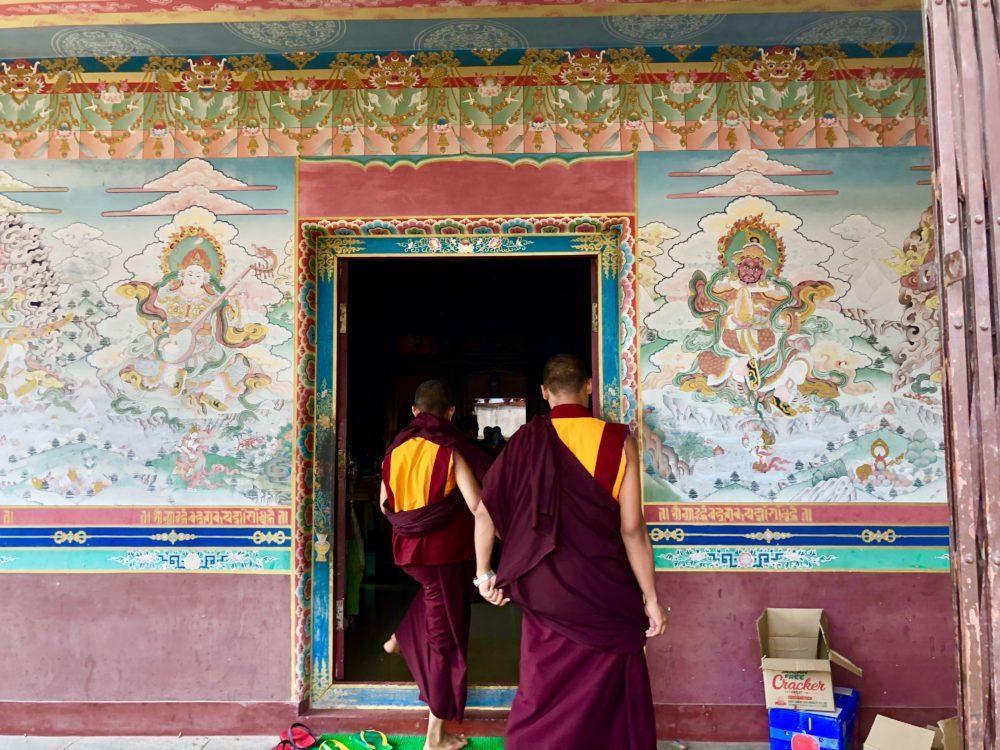
Asura cave is also known as the ‘Upper cave of Yangleshö’. Tulku Urgyen Rinpoche explains that: “In the innermost recesses of the Asura Cave… is a tunnel that connects this cave to the Yangleshö Cave down below, about half a mile away. It is not a big hole. Wind passes through this passage and you can feel the draft when sitting near it. Although Padmasambhava could traverse freely through solid matter, he used this narrow tunnel to move between Yangleshö Cave and the upper Asura Cave.”
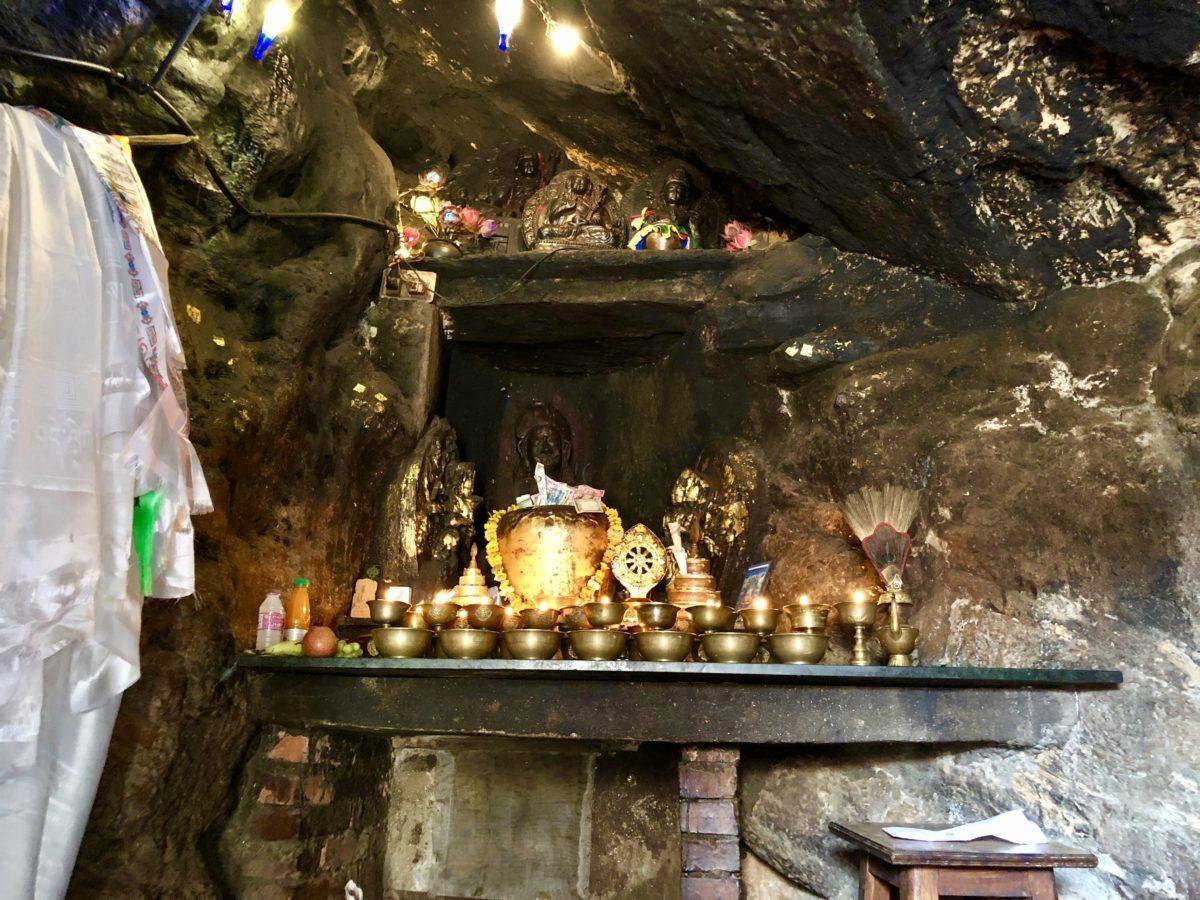
Inside the Asua cave, the energy is elecrifying. We sat and meditated for a while, and I am still burning. Around the cave is the monastery where several monks live and study.
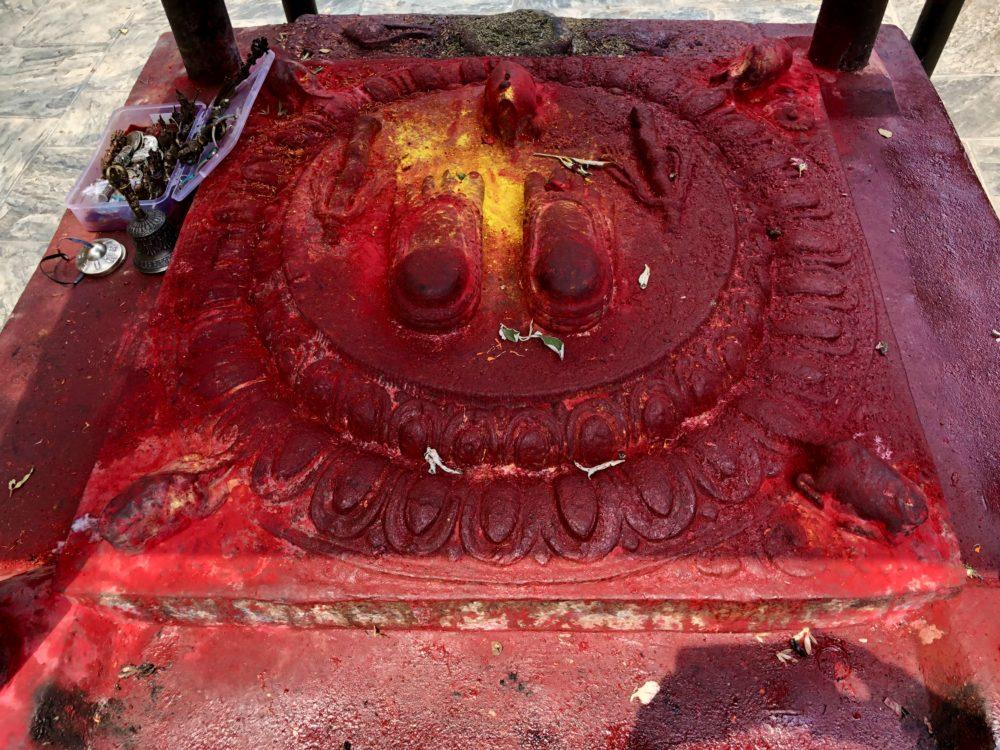
Outside the entrance to the cave sits an image of the feet of Rinpoche Padmasambhava.

The Amideva Buddha Park has three enormous statues on a hill. In the center is Gautama Buddha, flanked by Avalokiteshvara on the left and Padma Sambhava far right.
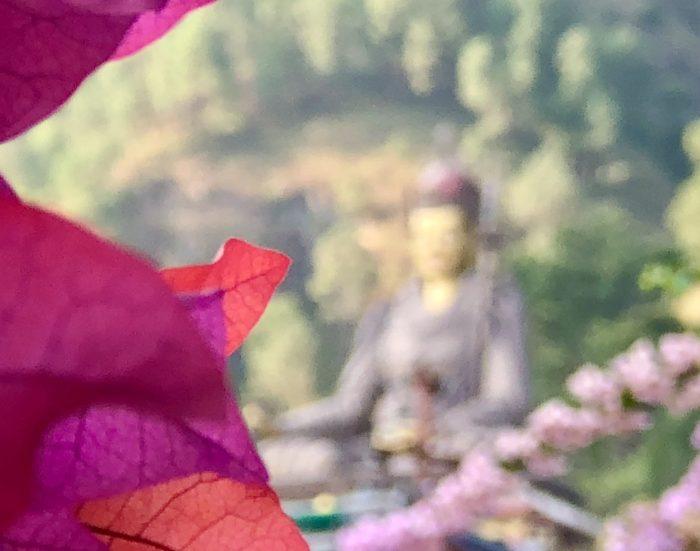
In Pharphing near Kathmando is a huge statue of PadmaSambhava.

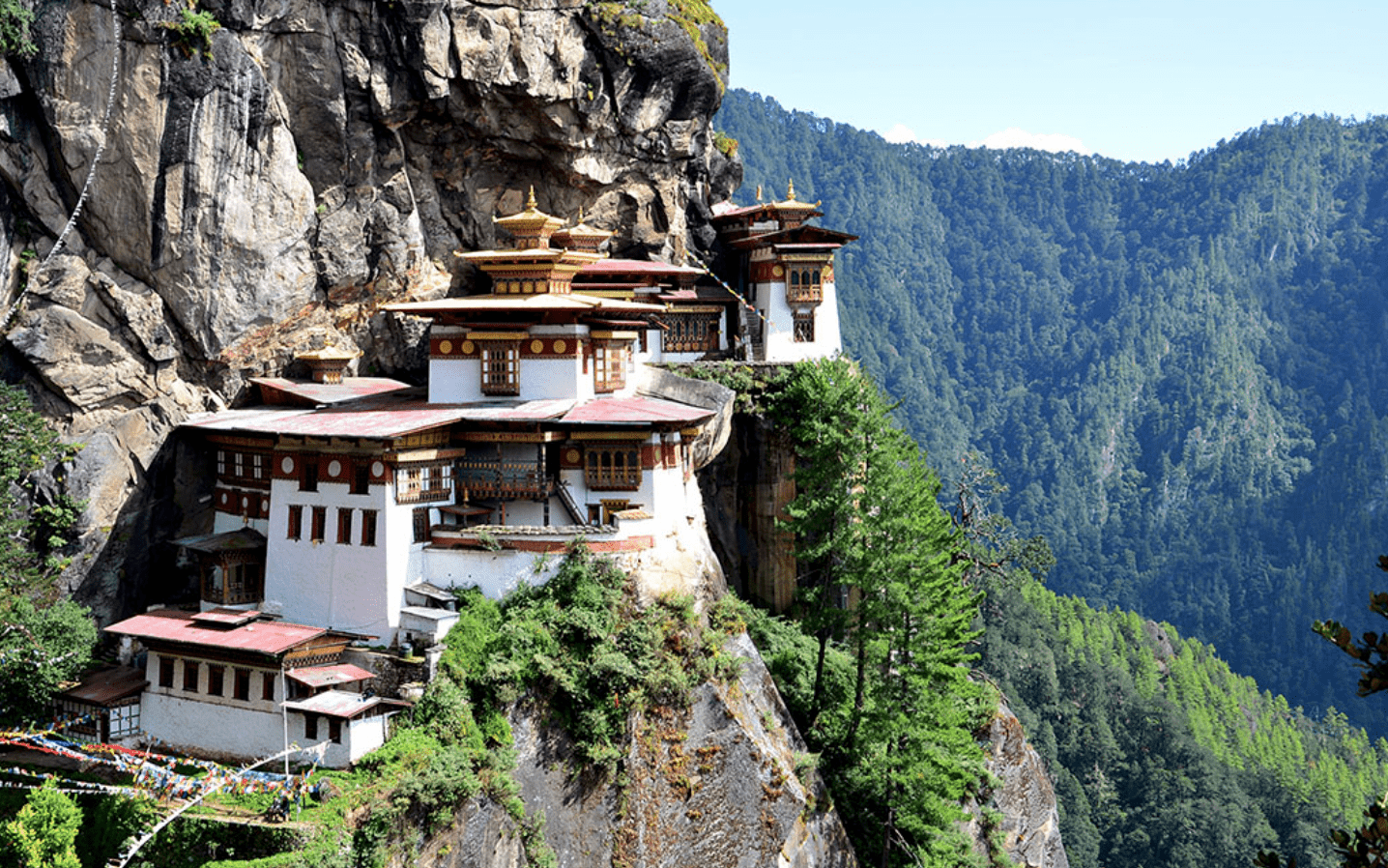

Tiger’s Nest, or Taktsang monastery is about 10 km north of the town of Paro town, at 3,120 m (10,236 feet).
Tiger’s Nest Temple
One of Bhutan’s most famous cultural sites is Taktsang, or “The Tiger’s Nest Monastery”, which clings impossibly to the side of a sheer cliff, and is one of the most holy temples in the kingdom. It is one of thirteen small monasteries or “tiger’s lairs” where Guru Rinpoche is said to have meditated.
Legend states that Guru Rinpoche, Padmasambhava, flew to the site atop the back of a tigress and meditated in the cave for 3 years in order to subdue evil demons residing within it. Legend goes that the great master Padmasambhava was called to Bhutan from Tibet to subdue demons who were causing difficulties for people of Paro Valley. He flew from Tibet to Bhutan on the back of a tigress. It is said that the tiger who carried the Guru was actually his consort, Yeshe Tsogyel, who assisted him in bringing Buddhism to the Land of the Thunder Dragon.

A painting of Guru Rinpoche and a tiger on the wall of Paro Dzong.
In order to reach the Taksang temple visitors must trek up the mountain for three hours through beautiful pine forests. No trip to Bhutan is complete without a visit to this remarkable heritage site.
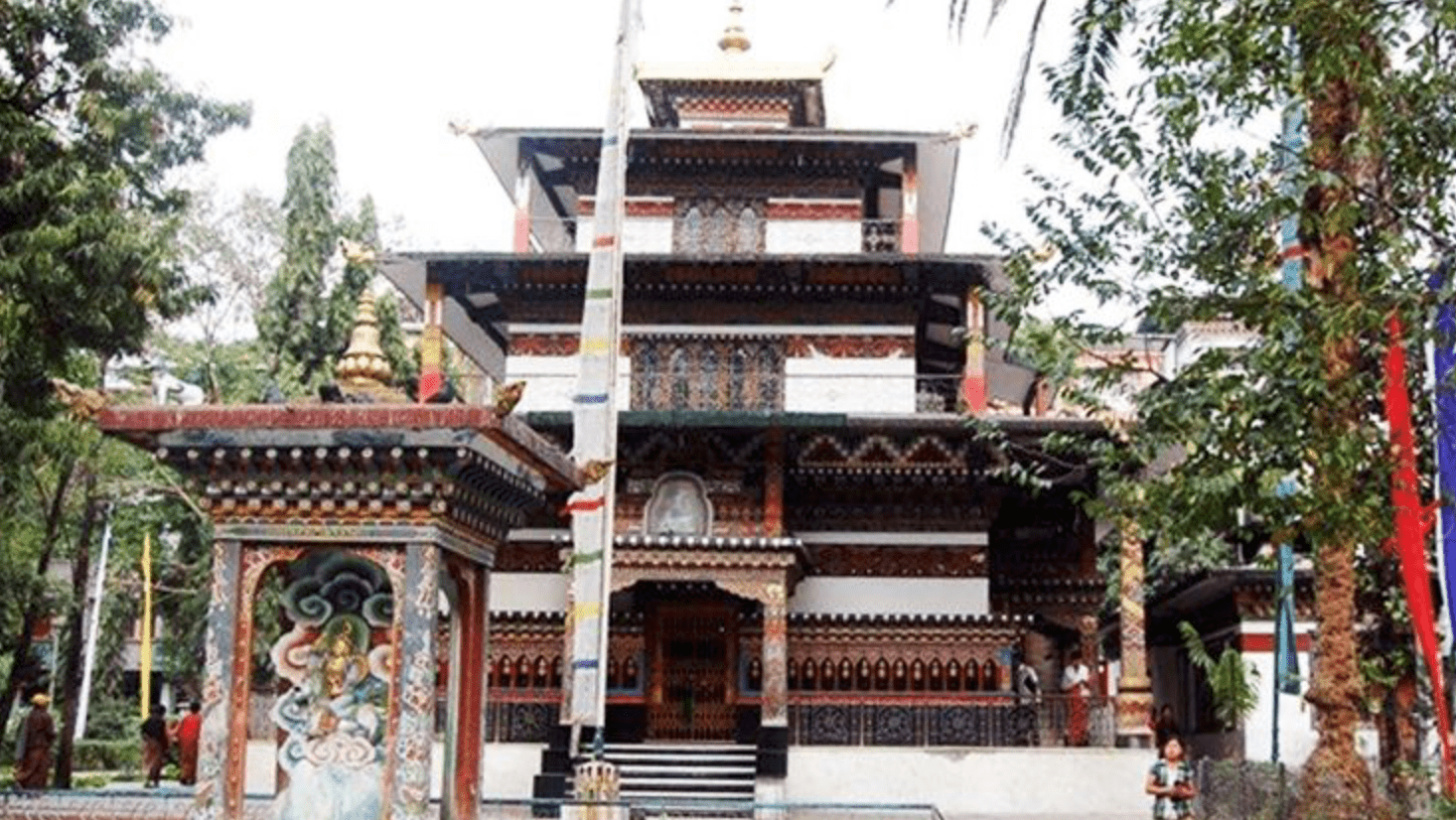

Padmasambhava taught many ways to call in the powers of the universe. The primary chant used to summon his energy for protection and guidance is the prayer above. The meaning is so esoteric that it’s beyond translation. Think of it as saying this powerful mantra: “Summon His Guidance and Protection”. Just 12 syllables. Try saying it:



